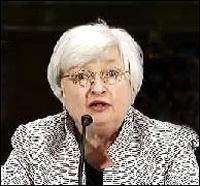By Pam Martens and Russ Martens: October 6, 2014
America’s central bank, the Federal Reserve, has a credibility problem and a management crisis unique to its unusual structure. If the Chair of the Federal Reserve Board of Governors, Janet Yellen, had any real management powers, she would have immediately asked William Dudley, President of the New York Fed, to step down after internal tape recordings revealed that his staff rubber stamps “legal but shady” deals at the big Wall Street banks it supervises. “Legal but shady” and patently illegal dressed up as just shady deals collapsed this Nation’s financial system only six years ago and continues to depress the country’s economic growth.
The tapes were released by former New York Fed bank examiner, Carmen Segarra, via the public interest web site ProPublica and public radio’s “This American Life.” Segarra is suing the New York Fed, charging that she was terminated when she refused to change her negative examination of Goldman Sachs – a position given substantive credibility with the release of the tapes.
Yellen’s credibility as the head of America’s central bank is undermined by these disclosures because many Americans believe that “the Fed” is the New York Fed because of its gold vault, historic building and decades of guided tours. But the New York Fed is just one of 12 regional Federal Reserve banks over which the Federal Reserve Board of Governors in Washington D.C., chaired by Yellen, oversees in what must be considered a titular capacity.
Yellen can’t fire Dudley or any other Fed Bank President because each regional Fed bank has its own Board that selects its President. The Federal Reserve Board of Governors in Washington, D.C. is given the ability to “approve” the appointment.
According to the New York Fed’s web site, a “principal responsibility of each Reserve Bank board is to select a Bank president who, in its judgment, will be qualified to participate in the monetary policy deliberations and decisions of the Federal Open Market Committee.”
Even when the public is aghast at conflicts of interest and newspaper editorial boards are clamoring for change, the Federal Reserve Board of Governors in Washington, D.C. sits essentially powerless to protect its own reputation from conflicts at the New York Fed.
Take, for example, the outrage over JPMorgan CEO, Jamie Dimon, sitting on the Board of Directors of the New York Fed in 2012 while his firm was being investigated by the institution for losing $6.2 billion in bank depositor funds through exotic derivative bets in London. The scandal became infamously known as the London Whale debacle because of the size of the bets. Dimon continued to sit on the Board, despite a groundswell of public outrage, serving out his two terms which ended at the end of 2012.
In March of 2013, Senator Carl Levin told the Senate’s Permanent Subcommittee on Investigations that JPMorgan, in carrying out the London Whale trades, “piled on risk, hid losses, disregarded risk limits, manipulated risk models, dodged oversight, and misinformed the public.” All while its CEO sat on the Board of its regulator, the New York Fed.
The New York Fed, in many ways, has far more power than Fed Chair Janet Yellen. Unfortunately, that power is hopelessly interlinked with Wall Street’s largest firms, rendering its role as a regulator fatally conflicted.
The New York Fed is unique among its sibling regional banks in the following ways:
The President of the New York Fed sits permanently on the Federal Open Market Committee (FOMC), the body that carries out monetary policy for the Fed through the New York Fed’s authorized interventions in money markets – all involving the participation of the largest banks on Wall Street. The Presidents of the other 11 regional banks rotate on the FOMC. The New York Fed has uniquely served in this function since 1935;
The New York Fed is the only regional Fed Bank to have its own trading floor, styled after those on Wall Street, with its own Bloomberg terminals;
It is the only regional Fed Bank allowed to intervene in foreign exchange markets;
The New York Fed is authorized to store gold for foreign central banks, governments and international agencies;
During the financial crisis of 2007 to 2010, the New York Fed played the major role in disbursing trillions of dollars in secret, below market rate loans to global banking behemoths, both domestic and foreign. The largest recipient of those loans was Citigroup, capturing more than $2 trillion in revolving loans. It is now known that Citigroup was insolvent at the time of the loans.
Senators Elizabeth Warren and Sherrod Brown have called for Senate Banking hearings to examine what the Segarra tape recordings say about regulatory capture at the New York Fed. A separate hearing should examine how the credibility of our nation’s central bank and its chair, Janet Yellen, is being undermined by the New York Fed’s serial displays of deeply conflicted behavior.


